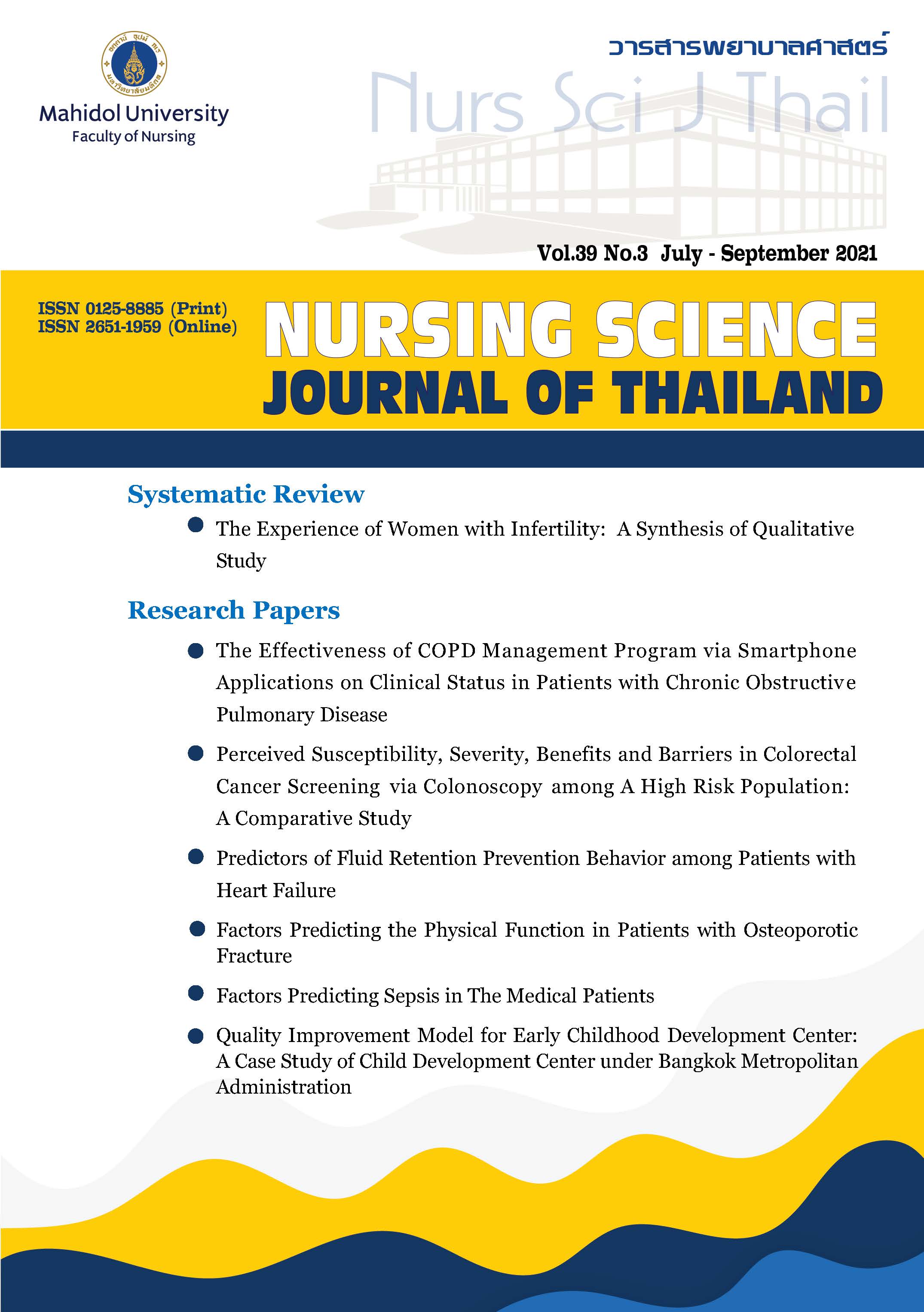Perceived Susceptibility, Severity, Benefits and Barriers in Colorectal Cancer Screening via Colonoscopy among a High Risk Population A Comparative Study
Main Article Content
Abstract
Purpose: To compare the perceived susceptibility of colorectal cancer risk and severity as well as the benefits and barriers related to screening colonoscopy in individuals with hereditary CRC or an age greater than 50 years between those who underwent and did not undergo screening colonoscopy at Songklanagarind Hospital.
Design: Cross-sectional comparative study.
Methods: Individuals with hereditary CRC or an age greater than 50 years (N = 165) recruited from Songkhla and nearby provinces were interviewed via telephone to assess their perceived susceptibility and perceived severity of CRC as well as the benefits of and barriers to screening colonoscopy using a set of questionnaires. Data were analyzed using descriptive statistics and Fisher’s exact test and rank sum test.
Main findings: There were 97 individuals in the adherence to colonoscopy screening group (59%) and 68 in the non-adherence group (41%). No significant differences regarding perceived susceptibility and perceived risk were found between the study groups. However, perceptions concerning the benefits of and barriers to colonoscopy screening were significantly different between the groups. Individuals who underwent colonoscopy perceived greater benefits (p = .002) and less barriers (p < .001), compared to their counterparts who did not undergo the screening.
Conclusion and recommendations: The perceptions of the benefits of and barriers to colonoscopy screening constituted adherence factors for undergoing this procedure. Therefore, it is recommended that medical personnel provide information highlighting the benefits of colonoscopy screening and assist minimizing the existing barriers to undergoing colonoscopy among high-risk populations.
Article Details
Copyright Notice: Nursing Science Journal of Thailand has exclusive rights to publish and distribute the manuscript and all contents therein. Without the journal’s permission, the dissemination of the manuscript in another journal or online, and the reproduction of the manuscript for non-educational purpose are prohibited.

Disclaimer: The opinion expressed and figures provided in this journal, NSJT, are the sole responsibility of the authors. The editorial board bears no responsibility in this regard.
References
Panchan W, Sugonyothin S, Chaiweerawatana A, Imsumran W. Screening, diagnosis and treatment guideline of colorectal cancer. Bangkok: Kosit Printing; 2015. 128 p. (in Thai).
Pietrzyk L. Food properties and dietary habits in colorectal cancer prevention and development. Int J Food Prop. 2017;20(10):2323-43. doi: 10.1080/10942912.2016.1236813.
Mishra N, Hall J. Identification of patients at risk for hereditary colorectal cancer. Clin Colon Rectal Surg. 2012;25(2):67-82. doi: 10.1055/s-0032-1313777.
Zauber AG, Winawer SJ, O’Brien MJ, Lansdorp-Vogelaar I, van Ballegooijen M, Hankey BF, et al. Colonoscopic polypectomy and long-term prevention of colorectal-cancer deaths. N Engl J Med. 2012;366(8):687-96. doi: 10.1056/NEJMoa1100370.
Roselló S, Simón S, Cervantes A. Programmed colorectal cancer screening decreases incidence and mortality. Transl Gastroenterol Hepatol. 2019;4:84. doi:10.21037/tgh.2019.12.13
Santos EM, Lourenco M Tc, Rossi BM. Risk perception among Brazilian individuals with high risk for colorectal cancer and colonoscopy. Hered Cancer Clin Pract. 2011;9(1):4. doi: 10.1186/1897-4287-9-4.
Rosenstock IM, Strecher VJ, Becker MH. Social learning theory and the Health Belief Model. Health Educ Q. 1988;15(2):175-83. doi: 10.1177/109019818801500203.
Atkinson TM, Salz T, Touza KK, Li Y, Hay JL. Does colorectal cancer risk perception predict screening behavior? A systemic review and meta-analysis. J Behav Med. 2015;38(6):837-50. doi: 10.1007/s10865-015-9668-8.
Rahimian Boogar I, Taepasand S, Norouzi H, Mozafari S, Hosseini SJ. The prediction of colorectal cancer screening based on the extended parallel process model: moderating the role of health literacy and cancer-related empowerment. Int J Cancer Manag. 2018;11(6):e62539. doi: 10.5812/ijcm.62539.
Williams RM, Wilkerson T, Holt CL. The role of perceived benefits and barriers in colorectal cancer screening in intervention trials among African Americans. Health Educ Res. 2018;33(3):205-17. doi: 10.1093/her/cyy013.
Galal YS, Amin TT, Alarfaj AK, Almulhim AA, Aljughaiman AA, Almulla AK, et al. Colon cancer among older Saudis: awareness of risk factors and early signs, and perceived barriers to screening. Asian Pac J Cancer Prev. 2016;17(4):1837-46.
Leung DYP, Chow KM, Lo SWS, So WKW, Chan CWH. Contributing factors to colorectal cancer screening among Chinese people: a review of quantitative studies. Int J Environ Res Public Health. 2016;13(5):506. doi: 10.3390/ijerph13050506.
Basch CH, Basch CE, Zybert P, Wolf RL. Fear as a barrier to asymptomatic colonoscopy screening in an urban minority population with health insurance. J Community Health. 2016;41(4):818-24. doi: 10.1007/s10900-016-0159-9.
Wong MCS, Ching JYL, Hirai HH, Lam TYT, Griffiths SM, Chan FKL, et al. Perceived obstacles of colorectal cancer screening and their association factors among 10,078 Chinese participants. PLoS One. 2013;8(7):e70209. doi: 10.1371/journal.pone.0070209.
Lee K. Measuring factors affecting colorectal cancer screening behavior and preference for colorectal cancer screening tests using the health belief model and a conjoint analysis [master’s thesis]. Goyang: National Cancer Center Graduate School of Cancer Science and Policy; 2019. 113 p.
Kim H-Y. Statistical notes for clinical researchers: Chi-squared test and Fisher's exact test. Restor Dent Endod. 2017;42(2):152-5. doi:10.5395/rde.2017.42.2.152
Jones CL, Jensen JD, Scherr CL, Brown NR, Christy K, Weaver J. The Health Belief Model as an explanatory framework in communication research: exploring parallel, serial, and moderated mediation. Health Commun. 2015;30(6):566-76. doi: 10.1080/10410236.2013.873363.
Carpenter CJ. A meta-analysis of the effectiveness of health belief model variables in predicting behavior. Health Commun. 2010;25(8):661-9. doi: 10.1080/10410236.2010.521906.
Champion VL, Monahan PO, Springston JK, Russell K, Zollinger TW, Saywell Jr RM, et al. Measuring mammography and breast cancer beliefs in African American women. J Health Psychol. 2008;13(6):827-37. doi:10.1177/1359105308093867.
Gimeno García AZ. Factors influencing colorectal cancer screening participation. Gastroenterol Res Pract. 2012;2012:483417. doi:10.1155/2012/483417.
Champion VL, Skinner CS. Differences in perceptions of risk, benefits and barriers by stage of mammography adoption. J Womens Health. 2003;12(3):277-86. doi.org/10.1089/154099903321667618.
Jones CL, Jensen JD, Scherr CL, Brown NR, Christy K, Weaver J. The Health Belief Model as an explanatory framework in communication research: exploring parallel, serial, and moderated mediation. Health Commun. 2015;30(6):566-76. doi:10.1080/10410236.2013.873363.


